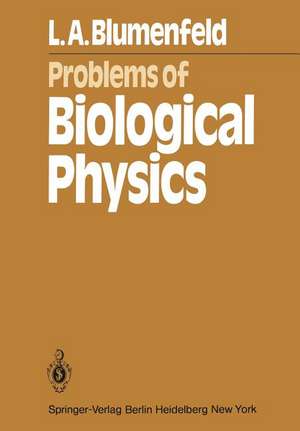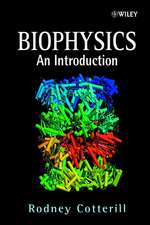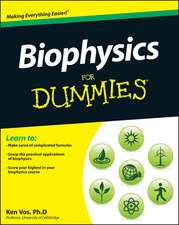Problems of Biological Physics: Springer Series in Synergetics, cartea 7
Autor Lev A. Blumenfeld Editat de Hermann Hakenen Limba Engleză Paperback – 16 dec 2011
Din seria Springer Series in Synergetics
- 15%
 Preț: 653.14 lei
Preț: 653.14 lei - 17%
 Preț: 430.21 lei
Preț: 430.21 lei - 17%
 Preț: 495.46 lei
Preț: 495.46 lei -
 Preț: 392.37 lei
Preț: 392.37 lei -
 Preț: 396.02 lei
Preț: 396.02 lei -
 Preț: 400.10 lei
Preț: 400.10 lei -
 Preț: 391.02 lei
Preț: 391.02 lei - 15%
 Preț: 641.38 lei
Preț: 641.38 lei - 18%
 Preț: 739.00 lei
Preț: 739.00 lei - 15%
 Preț: 645.60 lei
Preț: 645.60 lei - 15%
 Preț: 637.75 lei
Preț: 637.75 lei - 18%
 Preț: 727.31 lei
Preț: 727.31 lei - 20%
 Preț: 481.77 lei
Preț: 481.77 lei -
 Preț: 398.15 lei
Preț: 398.15 lei - 18%
 Preț: 742.97 lei
Preț: 742.97 lei - 15%
 Preț: 647.40 lei
Preț: 647.40 lei -
 Preț: 416.64 lei
Preț: 416.64 lei -
 Preț: 397.76 lei
Preț: 397.76 lei -
 Preț: 391.99 lei
Preț: 391.99 lei - 15%
 Preț: 644.49 lei
Preț: 644.49 lei -
 Preț: 386.99 lei
Preț: 386.99 lei - 20%
 Preț: 574.08 lei
Preț: 574.08 lei -
 Preț: 387.58 lei
Preț: 387.58 lei - 15%
 Preț: 533.53 lei
Preț: 533.53 lei -
 Preț: 396.02 lei
Preț: 396.02 lei -
 Preț: 390.25 lei
Preț: 390.25 lei -
 Preț: 392.37 lei
Preț: 392.37 lei -
 Preț: 396.40 lei
Preț: 396.40 lei -
 Preț: 408.16 lei
Preț: 408.16 lei - 18%
 Preț: 1116.09 lei
Preț: 1116.09 lei -
 Preț: 397.76 lei
Preț: 397.76 lei - 18%
 Preț: 971.64 lei
Preț: 971.64 lei - 15%
 Preț: 644.30 lei
Preț: 644.30 lei -
 Preț: 386.81 lei
Preț: 386.81 lei -
 Preț: 398.15 lei
Preț: 398.15 lei
Preț: 386.99 lei
Nou
Puncte Express: 580
Preț estimativ în valută:
74.05€ • 77.52$ • 61.27£
74.05€ • 77.52$ • 61.27£
Carte tipărită la comandă
Livrare economică 05-19 aprilie
Preluare comenzi: 021 569.72.76
Specificații
ISBN-13: 9783642678530
ISBN-10: 364267853X
Pagini: 240
Ilustrații: IX, 224 p.
Dimensiuni: 170 x 244 x 13 mm
Greutate: 0.39 kg
Ediția:Softcover reprint of the original 1st ed. 1981
Editura: Springer Berlin, Heidelberg
Colecția Springer
Seria Springer Series in Synergetics
Locul publicării:Berlin, Heidelberg, Germany
ISBN-10: 364267853X
Pagini: 240
Ilustrații: IX, 224 p.
Dimensiuni: 170 x 244 x 13 mm
Greutate: 0.39 kg
Ediția:Softcover reprint of the original 1st ed. 1981
Editura: Springer Berlin, Heidelberg
Colecția Springer
Seria Springer Series in Synergetics
Locul publicării:Berlin, Heidelberg, Germany
Public țintă
ResearchCuprins
1. Introduction.- 1.1 What is Biophysics?.- 1.2 Cell Components and Their Specific Features.- 1.3 The Aim of the Book.- 2. The Ordering of Biological Structures.- 2.1 Are They so Ordered in Reality?.- 2.2 Entropy and Information.- 2.3 What is the Cost of Biological Ordering?.- 2.4 The Meaning of Biological Ordering.- 2.5 The Necessity of Mechanical Details.- 2.6 The Problems.- 3. Nonequilibrium Thermodynamics and Biological Physics.- 3.1 Open Systems.- 3.2 Phenomenological Relations.- 3.3 Stationary States.- 3.4 Dissipative Structures.- 3.5 Oscillatory Phenomena in Chemistry and Biochemistry.- 3.6 The Problems.- 4. On the Statistical Physics of Biopolymers.- 4.1 Where does Mechanics Begin?.- 4.2 Statistical Physics of a Linear Homopolymer.- 4.3 On the Statistical Nonequilibrium of Biopolymer Structures at Different Levels of Organi zation.- 4.4 On Certain Properties of Biopolymer Structures that Can Be Understood in Terms of Their Statistical-Physical Description.- 5. Conformational and Configurational Changes of Biopolymers.- 5.1 Introductory Remarks.- 5.2 Biopolymer Denaturation.- 5.3 On the Difference Between Activation Energy and Activation Enthalpy.- 5.4 Some Protein Reactions.- 5.5 On the Compensation Effect.- 5.6 On the Validity of the Van’t Hoff and Arrhenius Equations and of the Activated State Theory for Biopolymer Reactions.- 5.7 On Spontaneous Conformational Oscillations of Protein Macromolecules.- 5.8 Conclusions.- 6. The Physics of Enzyme Catalysis.- 6.1 Background.- 6.2 Existing Interpretations of Enzymatic Activity.- 6.3 Conformational Changes as Necessary Steps of Enzymatic Processes.- 6.4 The Effect of Temperature on Enzymes and on the Activation Parameters of Enzyme Reactions.- 6.5 The Physics of Elementary Steps of Enzyme Catalysis [6.69,72,79,80].- 6.6 Dynamic Model for Aspartate-Amino-Transferase.- 6.7 Conclusions.- 7. The Physics of Electron Transfer in Biological Systems.- 7.1 Overview.- 7.2 Free Radicals and Radical Ions in Biochemical Reactions.- 7.3 Electron Transport Chains (ETC) in Mitochondrial and Chloroplast Membranes.- 7.4 Electron Transfer Reactions and Semiconduction in Biological Systems.- 7.5 On the Tunnelling Mechanisms of Electron Transfer Between the ETC Components.- 8. The Physics of Intracellular Energy Transformation and Accumulation.- 8.1 Overview.- 8.2 The ATP Problem.- 8.3 Substrate Phosphorylation.- 8.4 Membrane Phosphorylation: Thermodynamic Aspects.- 8.5 Membrane Phosphorylation: Existing Theories.- 8.6 Some Physical Aspects of Intracellular Energy Transformation as a Relaxation Process.- 9. Conclusion.- References.












